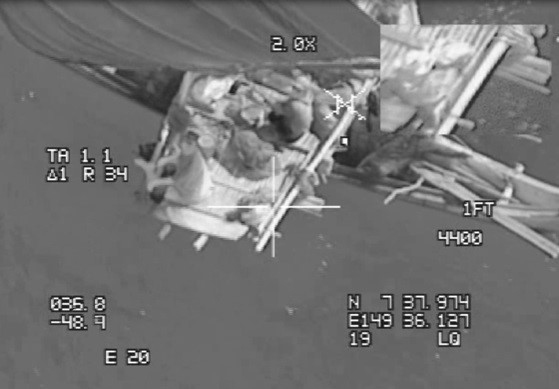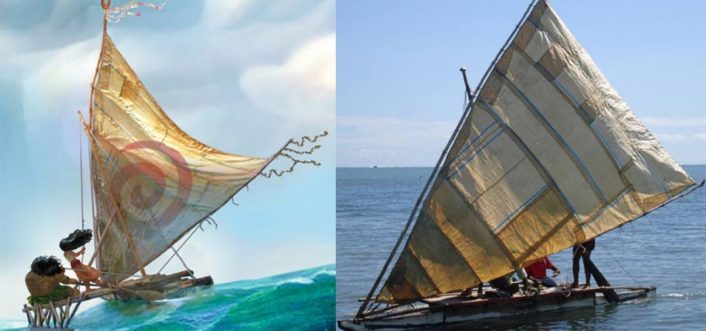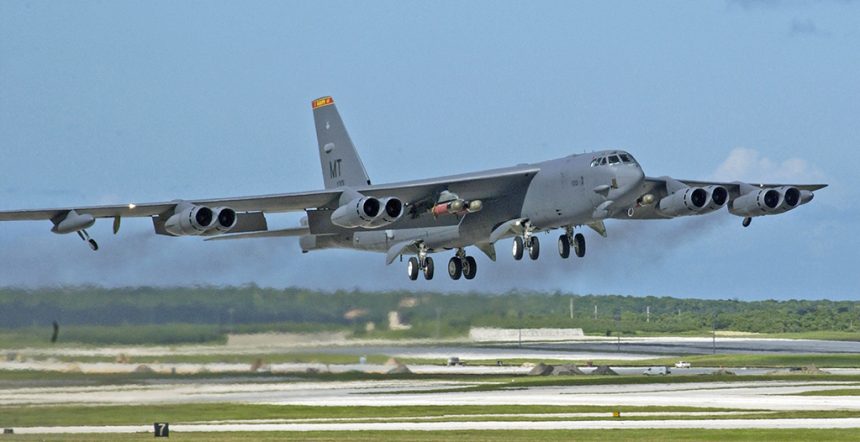In a Dramatic Open Ocean Search an Air Force Crew Finds Paddlers Missing Six Days. The lost canoe was located by the crew from one of the B-52H after it was compared to a similar one that appeared in a Disney cartoon.
A U.S. Air Force B-52H Stratofortress crew from the 20th Expeditionary Bomb Squadron, stationed at Barksdale Air Force Base, Louisiana, and deployed to Andersen Air Force Base in Guam are being hailed as heroes. The B-52H located the lost crew of an open ocean Polynesian-style canoe after they were missing at sea for six days.
The traditional Pacific Island-style canoe carrying six paddlers had become lost after sailing from nearby Piagailoe Atoll on June 19. The journey from the atoll to Guam was only supposed to take one day — meaning the paddlers, who had minimal supplies had been missing at sea for nearly a week.
Following the location of the canoers from the USAF B-52H, the six-member crew of the ocean-going canoe rendezvoused with a merchant vessel in the area that was directed to their location to effect rescue. The merchant vessel provided the canoers with water, food and navigational assistance so they could safely return to land.
The eight-engine, long range B-52H bomber joined the search when the crew from Barksdale Air Force Base, La., was on a routine flight during a deployment to Guam. The heavy bomber crew responded to a call from the Coast Guard for assistance in the search on June 25.
“This was a unique situation for us,” Capt. Sean Simpson, one of the bomber’s crew, said in an Air Force statement. “It’s not every day the B-52 gets called for a search and rescue.”
Initially the crew of the B-52H was unfamiliar with the type of vessel they were searching for. Coast Guard personal compared the small, difficult to spot indigenous canoe with the boat from the Disney cartoon “Moana”. Capt. Simpson told media, “We asked for more details about the vessel and the dispatcher told us, ‘It’s just like the boat from [the Disney film] ‘Moana.’”
The B-52H crew were able to locate the canoe and its crew at sea only three hours after being called into the search and rescue operation.
“We spotted this vessel from about 19,000 feet,” 1st Lt. Jordan Allen told Air Force media in the statement. “It’s really a small miracle that we were able to see it, because there was quite a bit of clouds.”

“Search and rescue isn’t something people typically think of when they talk about the B-52, but our training and adaptability really paid off,” Lt. Col. Jarred Prier, the bomb squadron’s director of operations, said in the statement. “Being a part of this successful search and rescue operation speaks to the diversity of our skill set and shows our importance here in the Pacific.”

While the 63-year old Boeing B-52 Stratofortress, first flown in 1952 and accepted into the Air Force in 1955, is oddly well suited for the maritime search and rescue role even though it was introduced as a global reach strategic nuclear bomber. The aircraft has an extremely long combat radius of 4,480 miles, meaning it can search out in a straight line 4,480 miles and return the same distance without refueling. Given midair refueling availability, the B-52’s endurance is limited mostly by its crew’s physical endurance.
In January 1957 three USAF B-52s set an endurance record by becoming the first jet aircraft to circle the earth on a non-stop flight. The early version B-52Bs flew continuously for 45 hours and 19 minutes. In total the planes flew 24,345 miles without landing.
Top image: a file photo of a B-52H from the 2nd Operations Group, the parent unit of the 20th Bomb Squadron. (Photo: U.S. Air Force)









